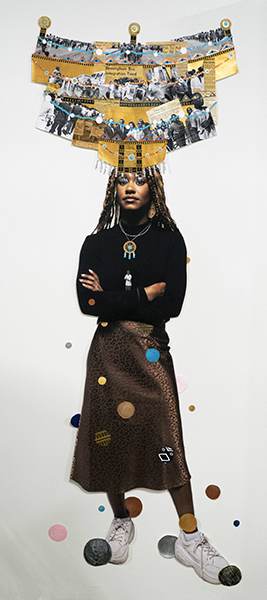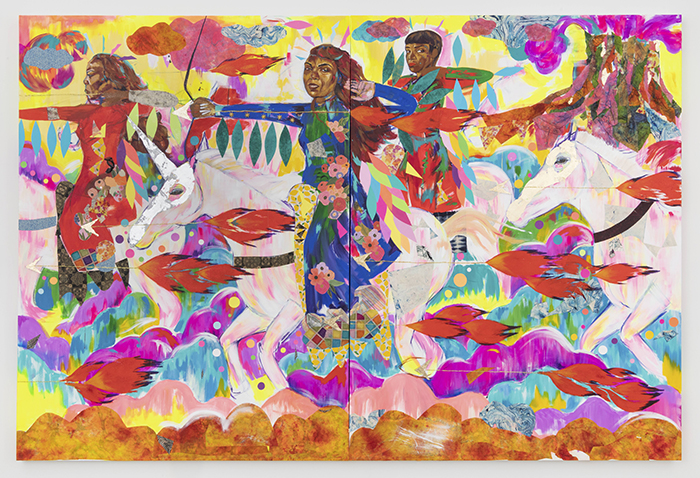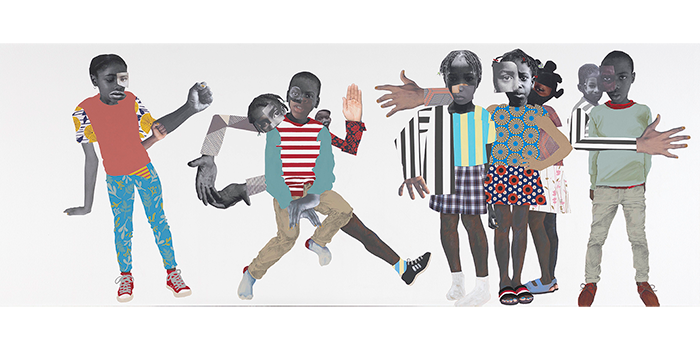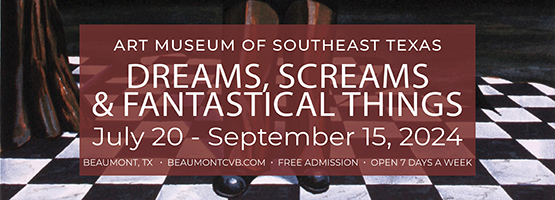The richness and diversity of collage as an expressive medium for Black artists first came to prominence with Romare Bearden, who began his collage work in the early 1960s. Bettye Saar created her first assemblages in the late ’60s, and other pioneering Black artists, including Jacob Lawrence and Faith Ringgold, embraced the process. Building on this legacy are the numerous Black artists who focus exclusively on collage or make it an important part of their practice.
Prominent artists such as Howardina Pindell, Kara Walker, Mickalene Thomas, and Kerry James Marshall are included, as well as established Texas-based artists like Rick Lowe, Deborah Roberts, Jamal Cyrus, Lovie Olivia, and Tay Butler. Although the show was organized by Nashville’s Frist Art Museum, MFAH associate curator Anita N. Bateman was involved early on, contributing an essay to the catalogue.
“I added a few dynamic Texas artists to highlight the quality of work being done in our city and state,” Bateman said. “Tay Butler was one of my recommendations, as was Yoyo Lander, who works in Manville, and Evita Tezeno, who is from East Texas and works in Dallas.”
Butler is a Houston artist who explores photography, collage, video, music, installation, and performance. His piece, Hyperinvisibility, deals with the adulation of professional basketball players by the culture whose opinions on anything other than their sport are often viewed as invalid. Austin-based Roberts uses distinctive portraits of children to comment on the failure of the white world to recognize Black beauty.
Multiplicity is organized around seven themes: Fragmentation and Reconstruction, Excavating History and Memory, Cultural Hybridity, Notions of Beauty and Power, Gender Fluidity and Queer Spaces, Toward Abstraction, and Digital Stitches.
The works of art in Fragmentation and Reconstruction are constructed with paper, denim, lace, wallpaper, glitter, feathers, string, sequins, photographs, and paint and include pieces by Roberts, Marshall, and Yashua Klos. Cyrus, who evokes Ghanaian Kente cloth with fragments clipped from newspapers and vintage Jet magazines, and Walker, known for her tableaux of cut-paper silhouettes that often address slavery, are part of the section on History and Memory.

1 ⁄7
Tschabalala Self, Sprewell, 2020, fabric, thread, painted canvas, silk, jeans, painted newsprint, stamp, photographic transfer on paper, and acrylic on canvas, Solomon R. Guggenheim Museum, New York, gift, image courtesy of the artist; Pilar Corrias, London; and Galerie Eva Presenhuber, Zurich. © Tschabalala Self

2 ⁄7
Helina Metaferia, Headdress 61, from the series By Way of Revolution, 2023, mixed- media collage, courtesy of the artist. © Helina Metaferia

3⁄ 7
Brittney Boyd Bullock, No It Ain’t, Yes It Is, 2023, mono printed paper, fabric, paper, acrylic, tulle, thread, felt, canvas, and tissue paper, courtesy of the artist. © Brittney Boyd Bullock

4 ⁄7
YoYo Lander, Countenance #5, 2022, stained, washed, and collaged watercolor paper on watercolor paper, courtesy of the artist. © YoYo Lander

5 ⁄7
Jamea Richmond-Edwards, Holy Wars, 2022, acrylic and mixed media on canvas, Bill and Christy Gautreaux Collection, Kansas City, Missouri, courtesy of the artist and Kravets Wehby Gallery. © Jamea Richmond-Edwards

6 ⁄7
Derek Fordjour, Airborne Double, 2022, acrylic, charcoal, cardboard, oil pastel, and foil on newspaper mounted on canvas, Frances Fine Art Collection, courtesy of the artist; David Kordansky Gallery; and Petzel Gallery, New York. Photograph: Daniel Greer © Derek Fordjour

7 ⁄7
Deborah Roberts, Let Them Be Children, 2018, mixed media and collage on canvas, Virginia Museum of Fine Arts, Richmond, Arthur and Margaret Glasgow Endowment, courtesy of the artist and Stephen Friedman Gallery. Photograph: Sydney Collins © Virginia Museum of Fine Arts © Deborah Roberts
In Notions of Beauty and Power, Zoë Charlton, Genevieve Gaignard, Tschabalala Self, and others explore and deconstruct notions of female beauty and power in the fine arts and popular culture. Gender Fluidity and Queer Spaces artists investigate their place in an increasingly non-binary world. Troy Montes Michie, raised on the U.S.-Mexico border, weaves together vintage images of fashionable Black men with abstract patterns that suggest the border wall. Lovie Olivia’s collages about A’Lelia Walker, thought to be the first self-made female millionaire in the U.S., highlight Walker’s Harlem soirees that welcomed queer people at a time when safe social spaces were rare. The last two thematic sections highlight abstract and digitally produced work by artists such as Howardina Pindell, Mark Bradford, Lowe, Arthur Jafa, Paul Anthony Smith, and Kahlil Robert Irving.
Delmez structured Multiplicity like a collage in that it brings together artists, authors, students, and professors, as well as participation by each host city’s Black community. She hopes the project will spawn future exhibitions that explore the medium’s power and reach.
—DONNA TENNANT





